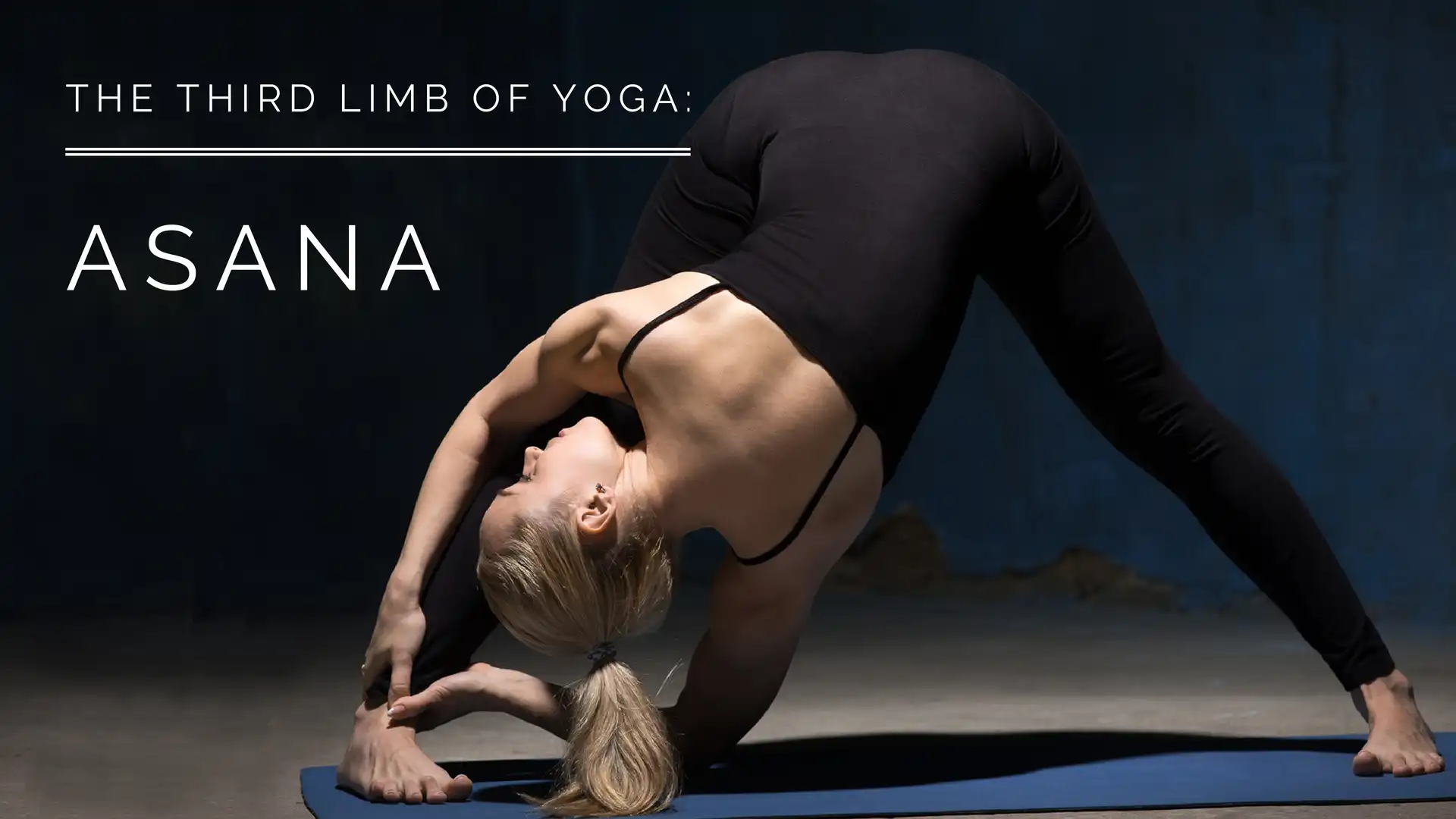The Third Limb of Yoga: Asana

When you imagine a yoga class, what comes to mind? Do you envision an array of sweaty bodies in Lululemon garb contorting themselves into pretzel-like shapes? Or perhaps you picture a roomful of fit and healthy yogis flowing gracefully through a series of challenging poses set to an ambient world music soundtrack.
In this modern age of yoga, many people have come to see these pretzel-like shapes and challenging poses, or asanas, as the definition of yoga. In reality, they’re just one aspect of a yoga practice.
Asana: The 3rd of 8 Limbs of Yoga

Asana is not the first, not even the second, but the third limb of Patanjali’s eight-limbed path of yoga (as delineated in his highly influential work on yoga philosophy, the Yoga Sutras). Even though asana is probably the most widely practiced of the eight limbs today, Patanjali only mentions the word in one of the 196 aphorisms that comprise the Sutras.
While “asana” now commonly refers to all the physical postures that we assume during the practice of yoga, its literal meaning is “sitting down” or a “seat.” When Patanjali wrote the Sutras around 400 C.E., he was most likely referring to a seat that one takes for meditation.
Not until centuries later did the first hatha yoga texts emerge, depicting several poses and broadening the meaning of “asana.” As asana evolved over the years and hundreds of postures were developed, the term has come to encompass all the standing, seated, or reclining poses that we practice today to strengthen and open the body.
Patanjali’s one mention of asana comes in sutra 2.46: sthira sukham asanam.
From the Sanskrit, Sthira means “steadiness” and Sukha means “ease.” In essence, Sutra 2.46 translates as “the seated posture should be steady and comfortable.”
By juxtaposing Sthira and Sukha, steadiness, and comfort, Patanjali advised the yogi to balance determination and ease within each asana.
Anyone who’s taken a yoga class knows how much effort is required to find steadiness in a pose. You must position your body meticulously and precisely. While certain muscles are engaging and contracting, others must lengthen and stretch. You must pay laser-like attention to detail to fine-tune your physical alignment while at the same time attuning yourself to the sensations arising within to access the subtle (energetic) body.
Since properly aligning yourself in each pose requires considerable effort, it’s easy to push too hard and overexert. If you contract the muscles too aggressively, they clench and become hard. If you ignore signals from the body in your desire to get a deeper stretch, you risk pulling or tearing a muscle.
Balancing Sthira and Sukha in Your Asana Practice

But you can learn to balance Sthira with Sukha. Figure out how to engage the muscles just enough, then search out tense places and soften as needed. Attune yourself to the sensations that come up and learn to recognize that place where you’re working hard enough to elicit vigor and strength but not so hard that you injure yourself.
Once you’ve engaged and opened sufficiently to create the pose, then you can relax your exertions and softly surrender to the present moment. You learn to dance along your edge: that place where you’re challenged but can still maintain your alignment, skill, and gentle awareness of your breath and the sensations that arise from moment to moment. You balance strength with openness, vigor with calm, and keen attention to detail with a lighthearted serenity.
If you’re newer to asana practice, this idea of relaxing within a pose might sound completely crazy. Even if you’ve been practicing for a while and never come close to experiencing tranquility in Downward Dog, don’t lose heart! It can take many years of practice to find that place within each pose where everything aligns beautifully, and you can stop working so hard and relax within the shape.
That’s why you get on your mat and practice repeatedly, day after day, year after year. It takes time, patience, and perseverance to embody the perfect balance of steadiness and comfort that Patanjali describes.
But sooner or later, you’ll have a moment when you come into that pose you’ve been struggling with and fighting against, and suddenly … ahhh. It all comes together, and you can breathe with ease, and your body feels engaged and spacious, aligned and open, strong and free.
When you finally discover how to tiptoe gracefully along the fine line that divides Sthira and Sukha, you might reach a state of equanimity and peace. Patanjali goes on to say in Sutra 2.47 that when you’ve found the place in the asana that embodies steadiness and comfort, “all effort relaxes and coalescence arises, revealing that the body and the infinite universe are indivisible.”*
By working consistently and patiently toward a balance between effort and ease, the dichotomy between the two eventually evaporates, and the body, mind, heart, and spirit are seamlessly integrated. The ultimate goal of asana is not to perfect our physical form but rather to move beyond the mere physical to achieve this integration.
Instead of being attached purely to the physical results of our practice, we open our eyes to what lies beyond the physical, to what Patanjali describes as “coalescence”: union, unification, and fusion with the pure awareness of infinity.
The corporeal practice of asana becomes an opportunity to illuminate that part of ourselves that transcends our flesh and bones. It gives us the tools to acknowledge and break through our attachment to the physical body to connect with something inside that is timeless, eternal, and infinite.
*Translation by Chip Hartranft
Another article from this series by writer Christine Malossi and YogaUOnline – The Fourth Limb Of Yoga: Pranayama.
 Christine Malossi, RYT 200, is based in New York City, where she offers a mindful, alignment-focused Vinyasa practice that cultivates balance, awareness, and stability. In addition to teaching private clients and group classes at studios throughout Manhattan, she also teaches at the Spencer Cox Center for Health at Mount Sinai Hospital’s Institute for Advanced Medicine, where she designs a practice specifically tailored to patients diagnosed with HIV and other chronic illnesses. Christine is honored to be teaching yoga and to have the opportunity to pass on to others the joy and freedom she has found in her practice. Find her at www.christinemalossi.com.
Christine Malossi, RYT 200, is based in New York City, where she offers a mindful, alignment-focused Vinyasa practice that cultivates balance, awareness, and stability. In addition to teaching private clients and group classes at studios throughout Manhattan, she also teaches at the Spencer Cox Center for Health at Mount Sinai Hospital’s Institute for Advanced Medicine, where she designs a practice specifically tailored to patients diagnosed with HIV and other chronic illnesses. Christine is honored to be teaching yoga and to have the opportunity to pass on to others the joy and freedom she has found in her practice. Find her at www.christinemalossi.com.



